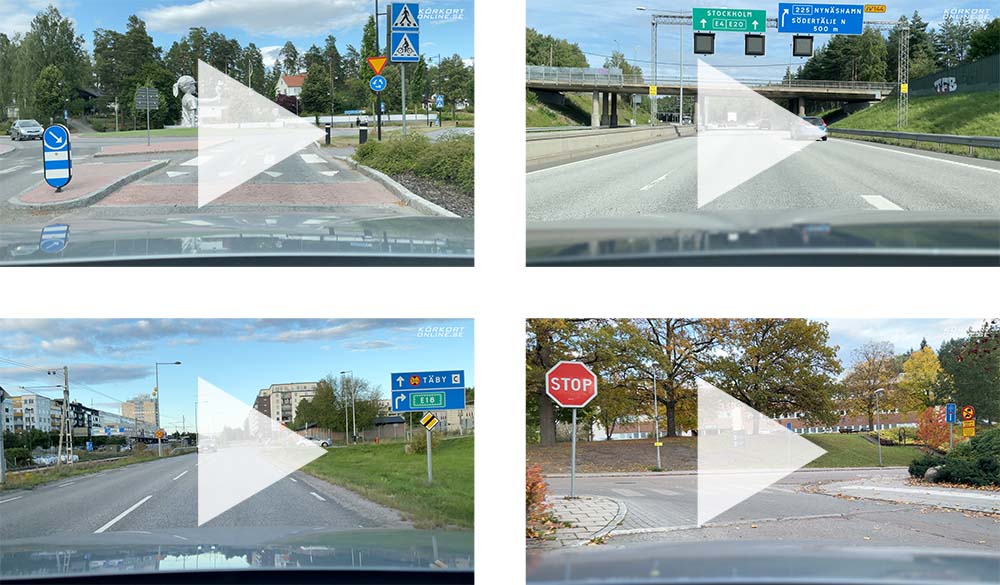Car brake system – driving licence theory
Dual-circuit brake system
Dual-circuit brake system means that the braking system is divided into two independent parts. If one circuit (brake for two wheels) fails, the second circuit (remaining two wheels) functions as normal. This increases the level of safety and is a feature of all but the oldest of cars.
Modern cars have hydraulic brakes. This means that the braking force is transferred from the pedal to the brakes with the help of a special brake fluid.

Wheel removed from a car with disc brakes. The brake caliper is the blue part.
Disc brakes
Disc brakes have an open brake disc and a caliper that is pressed against the disc when you brake. These brakes are the most common on new cars.
Drum brakes
Drum brakes have a closed construction consisting of a round drum. Inside the drum are brake shoes which are pressed against the drum when you brake.
ABS brakes
Anti-lock brakes (ABS) help you to maintain control of the car (manoeuvrability) in conjunction with forceful braking. The braking distance can be decreased, but in certain cases may be increased (e.g. on gravel).
How ABS brakes work
- You press down the brake pedal hard, which causes the wheels to lock and the car glides forward.
- The ABS system instantly senses that the wheels have locked (as they are not turning).
- The ABS system releases some of the pressure on the brakes so that the wheels begin to turn.
- The ABS system then adapts the braking force so that it is as strong as possible without becoming excessive and locking the brakes.
As the wheels are not locked, you can steer in conjunction with braking with ABS. This is very important if you need to swerve to avoid something.
When you brake hard in a car that is fitted with ABS, the pedal may begin to stutter and pulsate (it sounds as if something is wrong). This is entirely normal, however, as this is how the ABS system works.
You should continue to hold down the pedal as hard as you can, without releasing, however strange it feels.
Faulty brakes – test
In order to test the brakes, press the pedal down hard for 20 seconds and check for the following:
- If the brake pedal sinks very low, this indicates wear.
- If the pedal continues to sink slowly, despite the fact that you have reached the bottom, this means there is probably a leak in the brake system. This poses a very serious traffic hazard and must be rectified immediately.
- If the pedal feels springy, this may be due to air in the brake system. Take the car to a workshop to have this rectified.
It is also important to test the brakes once in a while. If the car is pulling to one side, it is time to take it to a workshop.
It is especially important to test the brakes after washing the car, as water can have a negative effect on them. Forceful, controlled braking will dry up the moisture.
Brake fluid

Brake fluid is normally yellow.
The brake lines are filled to maximum capacity and, when you press on the brake pedal, the brake fluid wants to exit via the other end. This is not possible, as the system is closed. The result is that the fluid presses on the brakes so that the car stops.
One problem with brake fluid is that it attracts moisture/water, which can lead to a deterioration of its properties. This means that it should be changed every two years.
Brake servo (vacuum servo)
Just like power steering, the brake servo helps by reducing the force required from you when depressing the brake pedal. The brake servo only works when the engine is running.
Test to see if the brake servo is working:
- Pump the brake pedal a few times with the engine switched off.
- Start the car with the brake pedal depressed.
- If the pedal sinks when the engine starts, the servo is working as it should.
Parking brake (handbrake)

Electronic parking brake.
The handbrake is there to stop the car from rolling when it is parked. This normally applies to the brakes on the back wheels. Things to consider with the handbrake:
- There is a risk that it may freeze in place in cold, damp weather.
- It may seize up if you do not use it regularly.
- In addition to the parking brake, it is good to put the car in first gear, as this further reduces the risk that the car will roll.
- Check to see whether the parking brake is working (does not work with electronic parking brake):
- Set the car rolling down a hill and then pull on the brake.
- Try to drive with the brake on.
Latest forum posts
- << Steering
- Brakes ↑↑
- Crash safety >>



